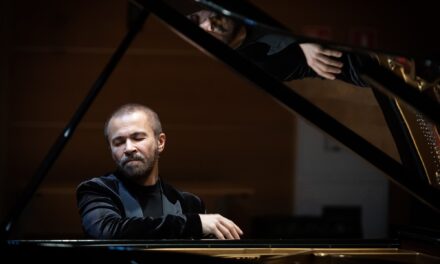It was in 1962, that American-born Ward Swingle first assembled an octet of Parisian session vocalists to sing Bach’s keyboard music. The resulting album, Jazz Sebastian Bach, became a music phenomenon that launched the Swingle Singers to fame. Over the past 50+ years they have gone through many iterations, pushing the boundaries of vocal music, developing a wide repertoire, and winning five Grammy awards. Today’s London-based Swingles are an international a cappella 7-voice ensemble, delivering folk ballads, funk jams, and yes, those amazing Bach fugues.
Listening to the local appearance of The Swingles at Stewart Theatre, on the campus of NCSU, it was perfectly clear that they are still a unique and audience-pleasing ensemble of very talented singers. Current personnel are Joanna Goldsmith-Eteson, Sara Brimer, Clare Wheeler, Oliver Griffiths, Jon Smith (as of four weeks ago), Kevin Fox, and Edward Randell. The engineer is Hugh Walker, tweaking sounds through an AKG WMS4500 wireless microphone system and IVM4 in-ear monitoring system.
There are three, nay, four elements that define the unique and recognizable sound of The Swingles: First is their use of scat – singing with undefined vocalizations, nonsense syllables, or without words at all. This is best illustrated by their renditions of Bach and other Baroque composers. The second piece on the program was an excerpt from one of the Corelli concerti grossi demonstrating crisp, clean vocalizations of difficult runs and ornamental patterns.
After the intermission, there was a little tease about singing Bach: a “But not now – later” kind of thing. Finally, about halfway through the second half, they broke out in the amazing and familiar Swingle Singers’ most recognizable sound: J. S. Bach’s “Little Fugue.” It is still a remarkable experience to hear this music, written some three hundred years ago for the organ, come vibrantly alive in this jazz-spiced format.
The second element of the Swingles’ sound is the tight, rich harmony that takes advantage of the full tonal and dynamic range of human voice, both female and male. Whether singing a folksong from the Philippines or Turkey or a current pop hit like Mumford and Sons’ “After the Storm” or an original song like “Reservoir,” the harmonies hint at purple velvet, the dissonances sweetening the song with easy tension and comforting resolution.
The third Swingles sound element is the use of the vocal apparatus as an instrument or, more accurately, as a variety of instruments including percussion. This is related to scatting but goes beyond that. Listening to “Couldn’t Love You More,” you would believe there was a double bass and a set of traps somewhere on the stage. But is was all done with breath, vocal chords, lips, tongue, and teeth. Of course, you need a bass singer whose lower register descends to the nether reaches. There were selections that allowed various individuals in the group to demonstrate extraordinary vocal agility in this technique.
Another winsome element of the Swingles is their covering of songs well chosen from the pop repertoire, like my favorite by Simon and Garfunkel. That amazing song that visualizes a full-length movie in three and a half minutes of singing – “America.” It was sung true to the original and enhanced with the Swingles sound. The Beatles’ “Blackbird” was done in an ethereal shadowy mood that was gorgeous.
The fourth element shaping the Swingles sound is the modern electronic equipment mentioned earlier. One number illustrated how looping can add richness to the total harmonic effect. This is the process wherein a sound sample is recorded and played back in a continuous loop while the singers continue developing the music over top it. Other devices added reverb or echo effect, enhanced lower or higher pitches, brought one voice forward, etc. But when it came to the actual singing…, that required talent and skill, unerring accuracy of intervals, acute awareness of what the rest of the ensemble was doing, precise timing, and a well-developed sense of artistry. All that the Swingles put on display in their varied program of uncommon entertainment.












